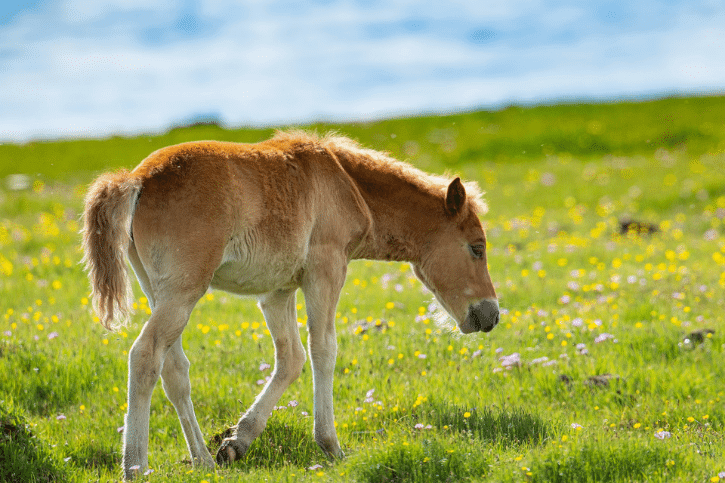How Many Stomachs Does A Horse Have?
I recently read the story of Tom Thumb to my son, and he was amazed to learn that cows have multiple stomachs.
I explained that actually, quite a few animals had more than one stomach, and in general a different number of organs than we do.
We have our own horses on our homestead, so almost straight away the first question he asked me was how many stomachs does a horse have?
I realized I actually wasn’t sure, so before I gave him an answer, I decided to look into it.
So, how many stomachs does a horse have?
Horses have only one stomach. Horses have simple, single compartments in their stomach. For most animals, needing multiple stomachs is about being about how they break down their food. Horses break it down in such a way that multiple stomach compartments are not necessary.
So, it’s much simpler when it comes to horses’ digestive systems.
Like us, they don’t have multiple stomach compartments that each do a different job in terms of breaking down specific foods.
There are a few reasons why horses have only one stomach whereas other animals with similar diets have several, so let’s look in a bit more detail.
Why don’t horses have multiple stomachs?
In most ruminants, like goats, you have what is called foregut fermentation.
Cows and other ruminants have various adaptations to break down the food they eat, and one of them is their multiple stomachs, but equally this is the foregut bacteria.
Food is broken down in the long GI tract, and cows have to chew a lot to help this along.
Horses, on the other hand, are what’s called hindgut fermenters.
The microbiomes in their guts break down the food once it has entered the horse’s cecum, after it has already passed through the stomach.
So, in the simplest sense, most of the digestion work is done after the food leaves the stomach.
There’s no real reason, then, for the horse to have multiple stomachs to break food down.
From an evolutionary point of view, many ruminants like cows and goats evolved on the fringes of habitats.
They had to be able to survive on whatever was available.
The abundance of grass certainly made this possible, and goes a long way to explaining why ruminants have been so successful over the generations.
The ruminants nonetheless needed to develop complex digestive systems to handle this.
Horses had no need for this, and were able to digest their food without a complex digestive system.
So, what about this distinction between horses and ‘ruminants’, then?
Why is a horse not a ruminant?
Horses are very similar and very closely related to many ruminant animals, but they themselves are not ruminants.
The distinction can be confusing at times, but it’s really essential to understanding their digestive systems.
First of all, the definition of a ruminant is an even-toed ungulate mammal that chews regurgitated cud from its rumen.
That means that it chews its food, swallows it, then regurgitates it and continues chewing.
A lovely image, I know!
But this is how animals like goats are apparently able to digest anything.
They have elaborate, complex systems for breaking down virtually any kind of nutrition they can get their hands on.
Horses do not regurgitate their cud, but simply allow it to be digested in their hindgut.
This is the main distinction of a ruminant, and the main other difference is that horses are not even-toed, but odd-toed.
They are still ungulates.
So, it’s a simple question of digestion and diet.
During the last ice age, the terrain of the face of the Earth was quite ubiquitous, and so things like goats and sheep thrived on the abundantly available grasses.
Horses had a somewhat more difficult time, but, obviously, the evolution of all of these animals was helped along significantly by humans.
Finally, what about a horse’s diet?
How can you describe it?
Is a horse an herbivore?
Many people think of horses as omnivores, for a lot of the same reasons people think of ruminants in this way.
Horses are, in fact, herbivores, and their diets should always remain very, very simple.
Almost all of it will be made up of grass grazing or hay, with some fresh fruit or vegetables as an occasional treat.
Despite their size, horses are a lot more sensitive to illness from foods that aren’t good for them, partly because of their much simpler digestive systems.
With only one, simple stomach, they don’t have room to digest much else!
So, yes, your horse is an herbivore, and you should always keep this strictly in mind when feeding it.
So, horses just don’t need multiple stomach compartments thanks to the way their digestive system is arranged.
Unlike other ruminants, their diets are quite particular due to their lack of extra stomachs.
Horses can only effectively digest quite select foods, whereas ruminants with multiple stomach compartments are able to break down a greater array of foods.
Horses don’t need multiple stomachs, thanks to gut bacteria and their cecum.
